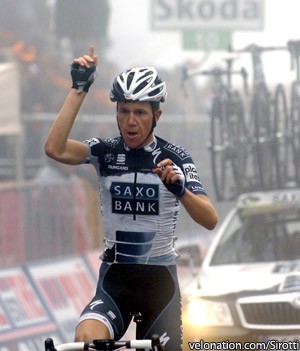Two difficult hills punctuate the final run-in to rainbow glory in Geelong
 While many have described the Worlds course in Geelong as difficult, few have taken the time to really describe the route that the riders will face. In his blog with Danish TV2, 2010 revelation, Chris Anker Sorensen, goes into detail about what the riders will face on Sunday.
While many have described the Worlds course in Geelong as difficult, few have taken the time to really describe the route that the riders will face. In his blog with Danish TV2, 2010 revelation, Chris Anker Sorensen, goes into detail about what the riders will face on Sunday.
Like most everyone, Sorensen scoffs at the idea of a flat route: “Those who have said it is totally flat, may have run incorrectly in their reconnaisance, because it is definitely not flat.”
Two climbs punctuate the final circuits, and the first is the nastiest of the two.
“The first climb is 1.1 km in the 9-10 percent range. I know perfectly well that I had very bad legs yesterday, so that just added to how much I suffered. The last 200 meters, it goes straight up into the sky and just to get over it you have to do 5-600 watts.”
The suffering on the difficult first climb will be punctuated by an extremely fast descent, where Sorensen expects speeds to hit around 90 km/h, this will form a section of the course that the winner of the Terminillo mountaintop finish at the Giro this year describes as “the course’s most treacherous passage.”
The descent is followed with a bridge crossing and then the second climb.
“At the bottom of the descent, we cross a bridge, which meanders a bit. Just after the bridge we go over a 5-600 meter climb, which shoots to 7-8 perfect. This climb is a placement one – the first part of the field will carry momentum up the first part of it, while the middle and last part of the peloton will come into the climb with a low speed.”
Riders at the tail end of the field will be hit hard with the two back to back climbs and the slow start to the final ascent. From the top of the climb, there remains five kilometers, and it’s here where Sorensen is not sure what will happen.
“After this hill, it’s approximately 5 kilometers to the finish. The first four drops a little bit, which of course speaks well for the sprinters and others to come back. The last kilometer is slightly uphill to the finish line.”
Taking a step back and looking at historical World Championships courses that the young rider has participated in, the Japan Cup winner from 2009 likens the course to the one in Salzburg where Paolo Bettini took his first World Championship.
“The hardness of the route reminds me of Salzburg, with the difference that the hills are a little harder.”
While there are similarities in the difficulty, the rather unique layout of this year’s course would seem to make for a different race according to Sorensen, but in the end, Sorensen feels the outcome could be very similar to the one seen in Salzburg a few years ago.
“One must remember though that we do 80 flat kilometers from Melbourne to Geelong, thus the real part of the day are the final five laps, and thus 10 climbs. The first 100 kilometers of the World Championships are not normally very difficult though – you just ride over the hills. So the scenario from Salzburg, where about 60 riders came to the finish, is also likely here.”
Moving from the race course itself, the ever improving Dane has suffered the slings and arrows of the outrageous time zone change from Europe to Australia, but has also struggled with riding on the right, er, left side of the road.
“There was one dangerous situation when we forgot that Australians drive on the left side of the road. So far, no one has been run down, so we are still a full team.”
The right-hand man for Andy Schleck at this year’s Tour de France will take part in the Worlds road race along with five other Danish teammates: Lars Bak, Matti Breschel, Anders Lund, Michael Morkov, and Alex Rasmussen.
If the race does in fact mimic the Salzburg edition of the World Championships, Robbie McEwen’s groan will likely be heard around the world. He was fifth there, winning the bunch sprint after the first four riders clipped away inside the final kilometre.